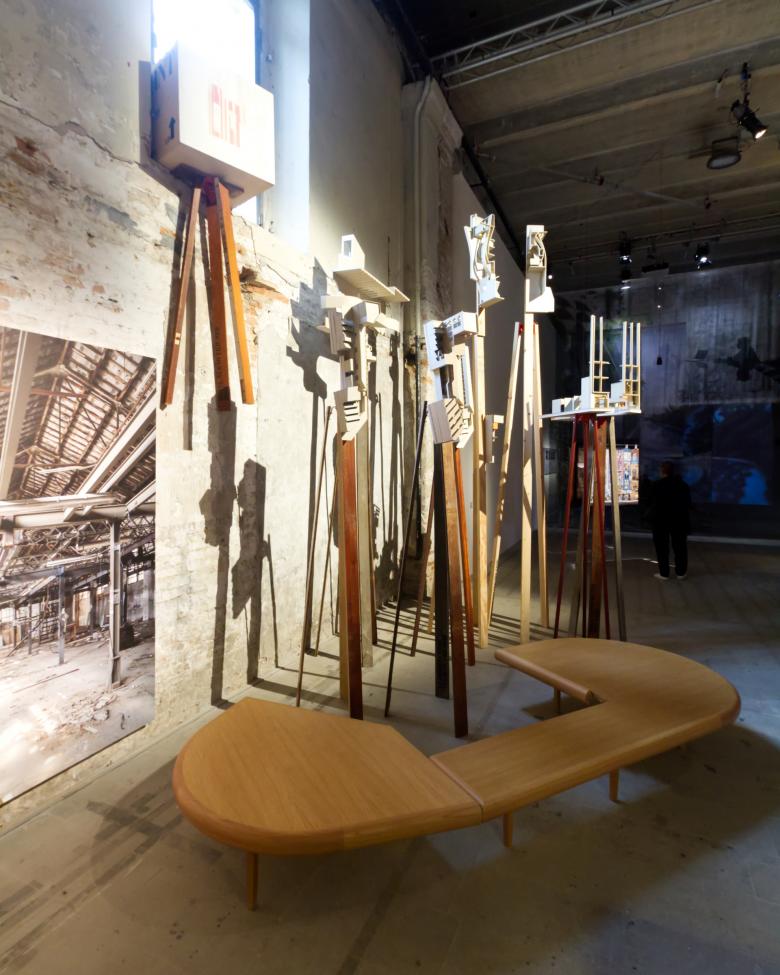Flores & Prats at the 2023 Venice Architecture Biennale
From Barcelona to Venice
Architects Ricardo Flores and Eva Prats have transported their studio on Carrer de Trafalgar in Barcelona to the Corderie building at the Arsenale, as part of the 2023 Venice Architecture Biennale. The large-scale installation's many drawings and models offer a revealing and rewarding peek into the working methods of Flores & Prats.
Emotional Heritage, as their installation for this year's Biennale is titled, is not the first time Flores & Prats have shipped their output from Barcelona to Venice. In 2018, as part of the FREESPACE Biennale curated by Yvonne Farrell and Shelley McNamara, the couple crafted a full-scale recreation of of the skylight from their Sala Beckett project for Liquid Light, a similarly large installation that also included a treasure-trove of models and drawings tracing the architects' process on the project. While that earlier installation was limited to one project, albeit one that brought Flores & Prats to the attention of more people outside of Barcelona and continues to be their most familiar creation, Emotional Heritage does a similar thing — but on a grander scale. Visitors to the Biennale will see documentation of Sala Beckett but also a handful of other Flores & Prats projects, both completed and in-progress, pieces of their studio that don't relate to projects (a floating dragon!), and even, as the photo at top reveals, a working model of the Biennale exhibition itself.
Below are photos from our tour of the installation during the vernissage in May, accompanied by captions with some additional information and impressions. At bottom is some brief commentary on a new book by Flores & Prats, Drawing without Erasing and Other Essays, released around the time of the Biennale opening and a suitable companion to it.
Although the models compete with the drawings in the installation — as attested by my photos above, the models win — Flores & Prats are more famous for their drawings, which clearly evoke their mentor and former employer Enric Miralles, are stubbornly hand-drawn, and are a treat for fellow architects to pore over. Drawings are the subject of a new book edited by Moisés Puente, Drawing without Erasing and Other Essays, but, as the title indicates, the primary means of explaining their drawings are words. And although Flores told me when I bumped into him at Emotional Heritage during the Biennale vernissage that he does not think he is a good writer (I disagree), his words and those of Prats benefit from the same honesty as their never-erase drawings. As such, the 17 essays and interviews in the book — four of them were previously unpublished — are a delight to read, and should be especially valuable for practicing architects in need of inspiration. Flores and Prats speak much about their process, from their thinking about the qualities of existing buildings to the way they draw in the studio and with their students; they reveal the books that were formative for them and continue to inspire them; and they delve into architects important to them, including John Hejduk and Ricardo Bofill. In many ways, the book parallels what is revealed in Emotional Heritage, namely how the act of “drawing with time” retains the thoughts, beliefs, concerns, and doubts that unfold over the course of a project — never erased, always there.

Flores & Prats: Drawing without Erasing and Other Essays
Edited by Moisés Puente
Foreword by Fabrizio Gallanti
14 x 21 cm
165 Pàgines
50 Illustrations
Paperback
ISBN 9783753303901
Koenig Books
Purchase this book











